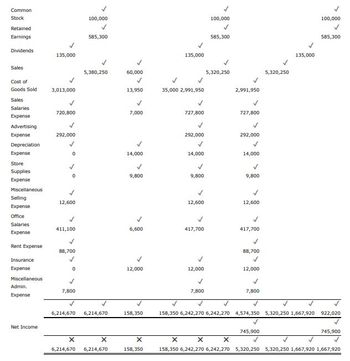Part 5: Optional work sheet Enter the unadjusted trial balance on a 10-column end-of-period spreadsheet (work sheet), and complete the spreadsheet using the following adjustment data. a. Inventory on May 31 b. Insurance expired during the year c. Store supplies on hand on May 31 d. Depreciation for the current year e. Accrued salaries on May 31: Sales salaries Office salaries Account Title 13,600 f. The adjustment for customer returns and allowances is $60,000 for sales and $35,000 for cost of goods sold. If an amount box does not require an entry, leave it blank. Cash Accounts Receivable Inventory Estimated Returns Inventory Prepaid Insurance Store Supplies Store Equipment Accum. Depr.-Store Equip. Accounts Payable Salaries Payable Customers Refunds Unadjusted Unadjusted Trial Trial Balance Balance Debit Credit 86,970 247,450 583,950 15,200 16,800 $7,000 6,600 13,800 569,500 ✓ 56,700 ✓ 63,150 ✓ 0 $570,000 12,000 4,000 14,000 29,270 Palisade Creek Co. End-of-Period Spreadsheet (Work Sheet) For the Year Ended May 31, 20Y6 Adjustments Adjustments Debit Credit Adjusted Adjusted Trial Trial Balance Balance Debit Credit 9,800 86,970 247,450 13,950 570,000 4,800 ✓ 4,000 569,500 Income Income Balance Balance Statement Statement Sheet Sheet Debit Credit Debit Credit
The Effect Of Prepaid Taxes On Assets And Liabilities
Many businesses estimate tax liability and make payments throughout the year (often quarterly). When a company overestimates its tax liability, this results in the business paying a prepaid tax. Prepaid taxes will be reversed within one year but can result in prepaid assets and liabilities.
Final Accounts
Financial accounting is one of the branches of accounting in which the transactions arising in the business over a particular period are recorded.
Ledger Posting
A ledger is an account that provides information on all the transactions that have taken place during a particular period. It is also known as General Ledger. For example, your bank account statement is a general ledger that gives information about the amount paid/debited or received/ credited from your bank account over some time.
Trial Balance and Final Accounts
In accounting we start with recording transaction with journal entries then we make separate ledger account for each type of transaction. It is very necessary to check and verify that the transaction transferred to ledgers from the journal are accurately recorded or not. Trial balance helps in this. Trial balance helps to check the accuracy of posting the ledger accounts. It helps the accountant to assist in preparing final accounts. It also helps the accountant to check whether all the debits and credits of items are recorded and posted accurately. Like in a balance sheet debit and credit side should be equal, similarly in trial balance debit balance and credit balance should tally.
Adjustment Entries
At the end of every accounting period Adjustment Entries are made in order to adjust the accounts precisely replicate the expenses and revenue of the current period. It is also known as end of period adjustment. It can also be referred as financial reporting that corrects the errors made previously in the accounting period. The basic characteristics of every adjustment entry is that it affects at least one real account and one nominal account.
I'm not sure what goes on the adjustments debit and credit column. Need help filling out the spreadsheet.


Trending now
This is a popular solution!
Step by step
Solved in 2 steps with 2 images

Journalize the closing entries. Indicate closed accounts by inserting a line in both the balance columns opposite the closing entry. Insert the new balance in the
I added all the items and got an incorrect for the totals on the spreadsheet and partical complete. I'm not sure what else I'm missing. Please help










